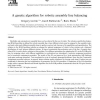Free Online Productivity Tools
i2Speak
i2Symbol
i2OCR
iTex2Img
iWeb2Print
iWeb2Shot
i2Type
iPdf2Split
iPdf2Merge
i2Bopomofo
i2Arabic
i2Style
i2Image
i2PDF
iLatex2Rtf
Sci2ools
EOR
2006
2006
A genetic algorithm for robotic assembly line balancing
Flexibility and automation in assembly lines can be achieved by the use of robots. The robotic assembly line balancing (RALB) problem is defined for robotic assembly line, where different robots may be assigned to the assembly tasks, and each robot needs different assembly times to perform a given task, because of its capabilities and specialization. The solution to the RALB problem includes an attempt for optimal assignment of robots to line stations and a balanced distribution of work between different stations. It aims at maximizing the production rate of the line. A genetic algorithm (GA) is used to find a solution to this problem. Two different procedures for adapting the GA to the RALB problem, by assigning robots with different capabilities to workstations are introduced: a recursive assignment procedure and a consecutive assignment procedure. The results of the GA are improved by a local optimization (hill climbing) work-piece exchange procedure. Tests conducted on a set of ra...
| Added | 12 Dec 2010 |
| Updated | 12 Dec 2010 |
| Type | Journal |
| Year | 2006 |
| Where | EOR |
| Authors | Gregory Levitin, Jacob Rubinovitz, Boris Shnits |
Comments (0)

